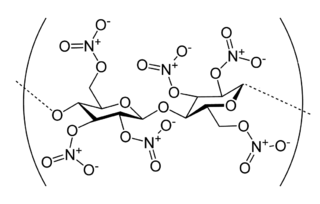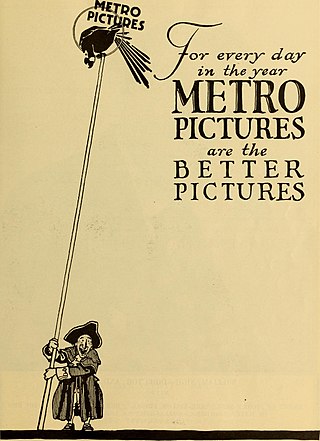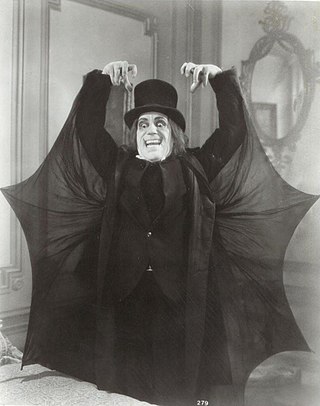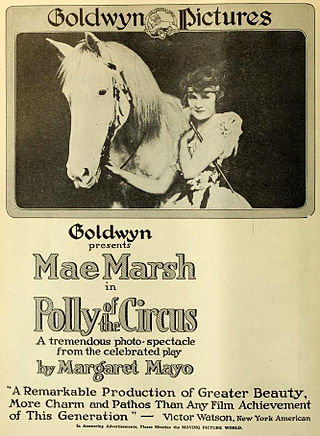Related Research Articles

A silent film is a film without synchronized recorded sound. Though silent films convey narrative and emotion visually, various plot elements or key lines of dialogue may, when necessary, be conveyed by the use of inter-title cards.

Nitrocellulose is a highly flammable compound formed by nitrating cellulose through exposure to a mixture of nitric acid and sulfuric acid. One of its first major uses was as guncotton, a replacement for gunpowder as propellant in firearms. It was also used to replace gunpowder as a low-order explosive in mining and other applications. In the form of collodion it was also a critical component in an early photographic emulsion, the use of which revolutionized photography in the 1860s.

Film preservation, or film restoration, describes a series of ongoing efforts among film historians, archivists, museums, cinematheques, and non-profit organizations to rescue decaying film stock and preserve the images they contain. In the widest sense, preservation assures that a movie will continue to exist in as close to its original form as possible.

London After Midnight is a lost 1927 American silent mystery horror film directed and co-produced by Tod Browning and starring Lon Chaney, with Marceline Day, Conrad Nagel, Henry B. Walthall and Polly Moran. The film was distributed by Metro-Goldwyn-Mayer, and was written by Waldemar Young, based on the story "The Hypnotist" which was written by Browning. Merritt B. Gerstad was the cinematographer, and the sets were designed by Cedric Gibbons and Arnold Gillespie. Harry Sharrock was the assistant director. The film cost $151,666.14 to produce, and grossed $1,004,000. Chaney's real-life make-up case can be seen in the last scene of the film sitting on a table, the only time it ever appeared in a film.

Goldwyn Pictures Corporation was an American motion picture production company that operated from 1916 to 1924 when it was merged with two other production companies to form the major studio, Metro-Goldwyn-Mayer. It was founded on November 19, 1916, by Samuel Goldfish, an executive at Lasky's Feature Play Company, and Broadway producer brothers Edgar and Archibald Selwyn, using an amalgamation of both last names to name the company.

Metro Pictures Corporation was a motion picture production company founded in early 1915 in Jacksonville, Florida. It was a forerunner of Metro-Goldwyn-Mayer. The company produced its films in New York, Los Angeles, and sometimes at leased facilities in Fort Lee, New Jersey. It was purchased in 1919.

A lost film is a feature or short film in which the original negative or copies are not known to exist in any studio archive, private collection, or public archive. Films can be wholly or partially lost for a number of reasons. Early films were not thought to have value beyond their theatrical run, so many were discarded afterward. Nitrate film used in early pictures was highly flammable and susceptible to degradation. The Library of Congress began acquiring copies of American films in 1909, but not all were kept. Due to improvements in film technology and recordkeeping, few films produced in the 1950s or beyond have been lost.
Preservation of documents, pictures, recordings, digital content, etc., is a major aspect of archival science. It is also an important consideration for people who are creating time capsules, family history, historical documents, scrapbooks and family trees. Common storage media are not permanent, and there are few reliable methods of preserving documents and pictures for the future.
MGM Home Entertainment LLC is the home video division arm of the American media company Metro-Goldwyn-Mayer (MGM). It is owned by the Amazon MGM Studios subsidiary of Amazon.

Associated Artists Productions, Inc. (a.a.p.) later known as United Artists Associated was an American distributor of theatrical feature films and short subjects for television. Associated Artists Productions was the copyright owner of the Popeye the Sailor shorts by Paramount Pictures, and the pre-1950 Warner Bros. Pictures film library, notably the pre-August 1948 color Looney Tunes and Merrie Melodies series of animated shorts, and the black-and-white Merrie Melodies shorts from Hugh Harman and Rudolf Ising, excluding Lady, Play Your Mandolin!.

The Sony Pictures Studios is an American television and film studio complex located in Culver City, California at 10202 West Washington Boulevard and bounded by Culver Boulevard (south), Washington Boulevard (north), Overland Avenue (west) and Madison Avenue (east). Founded in 1912, the facility is currently owned by Sony Pictures and houses the division's film studios, such as Columbia Pictures, TriStar Pictures, and Screen Gems. The complex was the original studios of Metro-Goldwyn-Mayer from 1924 to 1986 and Lorimar-Telepictures from 1986 to 1988.
A film base is a transparent substrate which acts as a support medium for the photosensitive emulsion that lies atop it. Despite the numerous layers and coatings associated with the emulsion layer, the base generally accounts for the vast majority of the thickness of any given film stock. Since the late 19th century, there have been three major types of film base in use: nitrate, acetate, and polyester.

Leo the Lion is the mascot for the Hollywood film studio Metro-Goldwyn-Mayer and one of its predecessors, Goldwyn Pictures. The logo was created by artist Lionel S. Reiss, who served as art director at Paramount Pictures.

Hello Pop! is the third of five short films starring Ted Healy and His Stooges released by Metro-Goldwyn-Mayer on September 16, 1933. A musical-comedy film, the film also featured the Albertina Rasch Dancers and Bonnie Bonnell. The film was considered lost until a 35mm nitrate print was discovered in Australia in January 2013. Stooges Moe Howard, Larry Fine and Curly Howard were billed as "Howard, Fine and Howard."

The Revenge of Tarzan (1920) is a silent adventure film, originally advertised as The Return of Tarzan, and the third Tarzan film produced. The film was produced by the Great Western Film Producing Company, a subsidiary of the Numa Pictures Corporation. The film was sold to Goldwyn Pictures for distribution.

Polly of the Circus is a 1917 American silent drama film notable as the first film produced by Samuel Goldwyn after founding his studio Goldwyn Pictures. This film starred Mae Marsh, usually an actress for D.W. Griffith, but now under contract to Goldwyn for a series of films. The film was based on the 1907 Broadway play Polly of the Circus by Margaret Mayo which starred Mabel Taliaferro. Presumably when MGM remade Polly of the Circus in 1932 with Marion Davies, they still owned the screen rights inherited from the 1924 merger by Marcus Loew of the Metro, Goldwyn, and Louis B. Mayer studios. This film marks the first appearance of Slats, the lion mascot of Goldwyn Pictures and Metro-Goldwyn-Mayer. Prints and/or fragments were found in the Dawson Film Find in 1978.

A major fire occurred in a 20th Century-Fox film-storage facility in Little Ferry, New Jersey, United States on July 9, 1937. Flammable nitrate film had previously contributed to several fires in film-industry laboratories, studios and vaults, although the precise causes were often unknown. In Little Ferry, gases produced by decaying film, combined with high temperatures and inadequate ventilation, resulted in spontaneous combustion.

On the morning of June 13, 1914, a disastrous fire and a series of related explosions occurred in the main film vault of the Lubin Manufacturing Company in Philadelphia, Pennsylvania. Several possible causes for the blaze were cited at the time, one being "spontaneous combustion" of highly flammable nitrate film, which was the motion picture industry's standard medium for cameras throughout the silent era and for the first two decades of "talking pictures". Millions of feet of film were consumed in the flames, including most of the master negatives and initial prints of Lubin's pre-1914 catalog, several of the company's recently completed theatrical prints ready for release and distribution, a considerable number of films produced by other studios, inventories of raw and stock footage, hundreds of reels documenting historic events that occurred between 1897 and early 1914, as well as other films related to notable political and military figures, innovations in medical science, and professional athletic contests from that period. While this fire was not a decisive factor in Lubin's decline and bankruptcy by September 1916, costs associated with the disaster only added to the corporation's mounting debts, which led to the closure or sale of its remaining operations the following year.
The 1978 Suitland National Archives Film Vault Fire was a fire at the National Archives and Records Administration Film Vault in Suitland, Maryland on December 7, 1978. The fire destroyed 12.6 million feet of Universal Pictures newsreel footage from 1929 to 1967, including film of the bombing of Pearl Harbor, other World War II combat footage and film from the time of The Great Depression.
References
- 1 2 3 4 "Explosion Hits MGM Film Vault". Evening Vanguard. August 11, 1965. p. 1 – via Newspapers.com.

- 1 2 3 4 5 6 Pierce, David (1997). "The Legion of the Condemned - Why American Silent Films Perished". Film History. 9 (1, Silent Cinema). Australia: Indiana University Press; John Libbey & Company. ISSN 0892-2160. JSTOR 3815289.
- 1 2 3 4 Pierce, David (September 2013). The Survival of American Silent Feature Films: 1912–1929 (PDF). Council on Library and Information Resources. ISBN 978-1-932326-39-0 . Retrieved March 21, 2018.
- ↑ Soister, John; Nicolella, Henry; Joyce, Steve; Long, Harry (2012). American Silent Horror, Science Fiction and Fantasy Feature Films, 1913–1929. McFarland. p. 333. ISBN 978-0786435814.